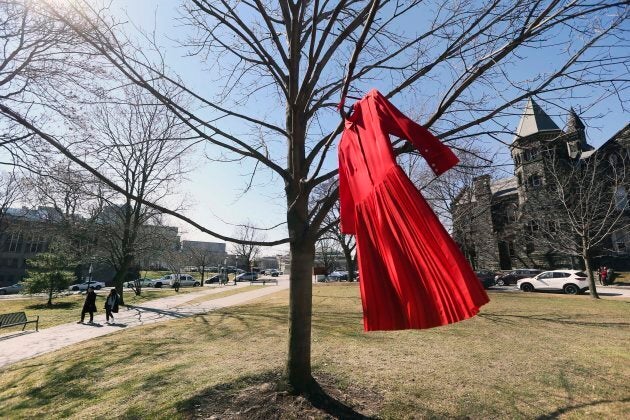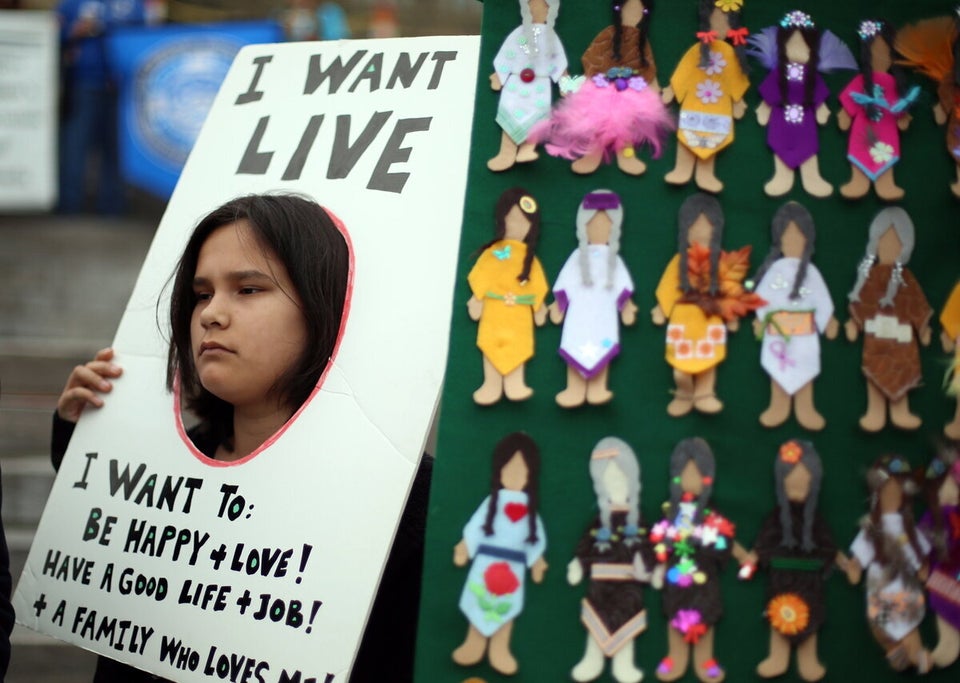Previously Published at Indian Country Today.
I've seen red dresses hung on trees, on campuses and elsewhere to honour murdered and missing Indigenous women. The aesthetic response is artistically stunning, but it's inanimate and pretty, and it's simultaneously disturbing when I consider the symbol isn't ascribed the value of purity or innocence. I support artistic endeavors to memorialize or create symbols, but I don't provide blind support to anything. If I'm beaten to death or go missing, don't hang a red dress for me.
Métis artist Jaime Black created the installation: "I'm allowing people to critically think about the issue... it's amazing how... powerful it is to see these dresses just hanging there, and when you walk by them it feels like you are walking by someone but no one is in them. It really works as a kind of visceral reminder of these women."

The red dress appears ghostly and impersonal, especially after it's become so familiar and synonymous -- I have come to resent when editors choose the red dress over a human face for stories about murdered and missing women, because I wonder about the danger and benefit of giving a cause to protect human life an image with no features, or life, or blood, or viscera.
Art isn't enough when it's meant for an active audience.
It isn't Black's fault that there is something amiss with the way in which Indigenous women are treated in North America. It's not her fault that the tally of women missing and murdered grows as the inquiry encounters set back after set back. The work served as an aesthetic reminder that there is a blaring, unsightly, crazy-making problem and if people cannot acknowledge the inherent racism, indignity and hatred Indian women face, they will at least have to acknowledge these images: a red dress in a stagnant winter forest, or the dresses picking up a cool breeze in the spring on a peaceful day...
It's what people do with the reminder that has fallen short. It's that art isn't enough when it's meant for an active audience.
Artwork like this doesn't need to be perpetuated for years without critical thought or discussion. The work is supposed to be talked about. Without that it becomes something static. The implication of a red dress signifying the absence of an Indian woman might be too much. Red doesn't symbolize promiscuity or sex work where I'm from. It's used to create positive and negative spaces, so I see the appeal in the dresses, but to majority culture the red dress doesn't signify power typically, or purity, or healing, but when have I ever cared about the average audience? Only when I'm trying to discern something's worth, or why it underwhelms me, or why I believe it might have a negative impact over its intent.
It's necessary to consider these things when I know I've witnessed enough domestic violence, sexual violence and brutality to where those artistic gestures hold personal value -- this work is close to me. Someone could hang a dress for me someday, god forbid. God forbid they would choose that aesthetic response to my death.
I'd prefer an effigy of my culprit to burn, hanging. I'd prefer something more than a dress, considering how rare it is I wear them. What about leggings, or a sign, "Death to my enemies." I entertain these morbid things when I consider the desperation of injustice. That it doesn't come sometimes, and all I can do is wonder what will any of us do if we lose another one. Can we keep hanging red dresses? It feels like pining for justice -- it feels like laying down a rose for something unrequited, and I guess that's what symbolic gestures are, because there's absence-- something we can't exact, and we try to make something tangible to memorialize -- physicalize our grief, yearning, idea or memory.
I wonder if there are enough dresses or symbols in the world to signify that pain and distress for Indigenous people.
I was poolside on the Fourth of July when I received news Barbara Kentner died. The woman, my age -- a mother, too, was hit by a trailer hitch in Thunder Bay. The white man who hit her shouted, "I got one," and drove away, and now she's gone. It mattered that I was enjoying my life that moment before, because I felt untouchable in some way. The news, every time another woman dies, breaks me hard.
I think about all the women who died that way, and others who worked their whole lives to the bone, and left behind debt, and deserved better; and I think about the men who died violently, too; and I think about my father, who was beaten to death, and I consider the violence he inflicted himself. I think about it all and wonder if there are enough dresses or symbols in the world to signify that pain and distress for Indigenous people.
With all the good intentions of the dress, or a tobacco tie, or any one single good thing -- I fear it pales to the willful ignorance of passersby, who won't engage -- not with a dress, or our bodies. I fear so much of our well-intended work pales, even our writing, to the men who abuse their power, or social workers who cannot be bothered to regard us, or to people who would prefer we be replaced with dresses. To what end, I think, every time I see a dress instead of the woman who should be there on that campus, or in that forest with her children, or in the breeze, anywhere but absent and unheard -- a dress.
Follow HuffPost Canada Blogs on Facebook
Also on HuffPost:
